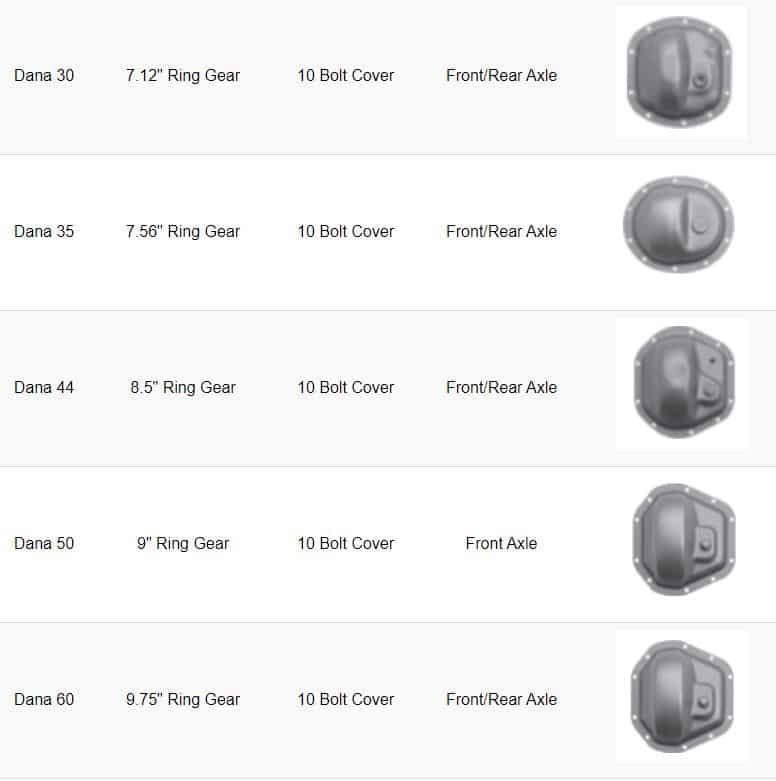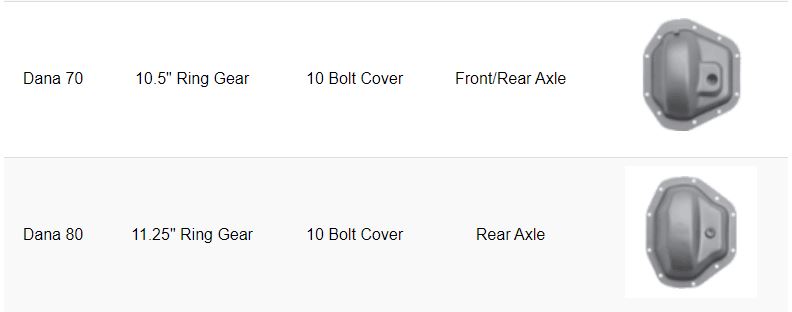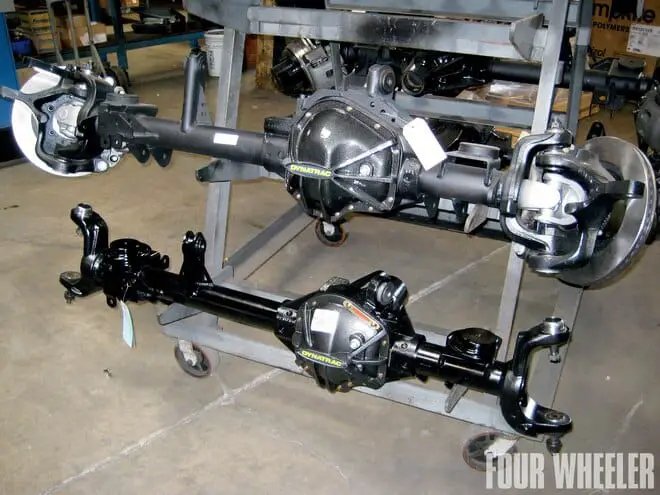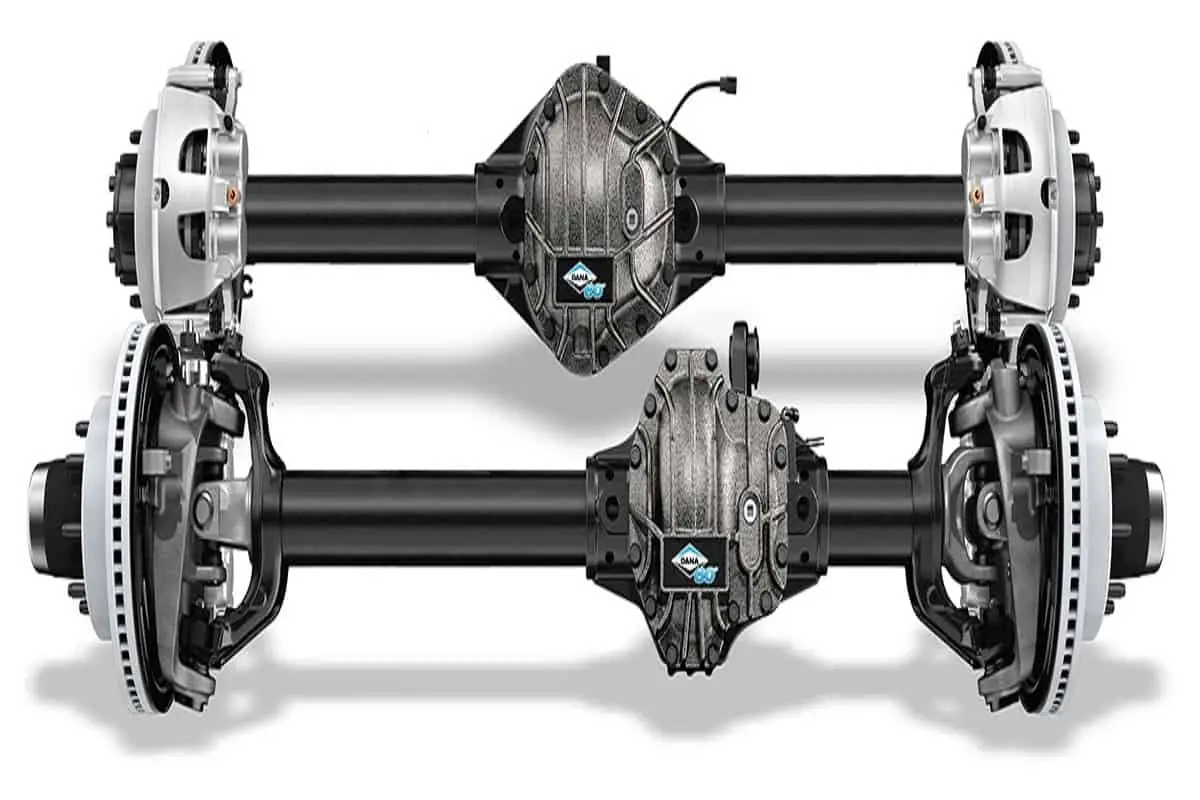You have a Jeep and now all you keep hearing about is someone named Dana Spicer. No worries, you came to the right place to learn everything you need about Dana and “her” axles.
So what is a Dana Spicer axle? Spicer is the brand name given to axle and drive shaft components made by Dana Incorporated. A long time trusted name in the off road community, Dana has been considered the standard for axles. Many axle manufacturers use Dana product names to describe the model and application of their axles and drive line products.
Just like Nike has many models of shoes for different purposes, Dana Spicer has several models of axles depending on what you need (or want). From a Dana 27 to a Dana S135, the Spicer brand has defined axles for any and every application.
Dana Spicer Axles and Specs
Axles vary far and wide in size and capabilities. You won’t find the same axle used for a small car tucked underneath a 3500 Diesel truck. Depending on the application of the vehicle, different axles should be considered.
When it comes to off-roading, many owners know the truth behind the saying “smile per gallon.” The truth is, when you are building a vehicle to handle anything you throw at it, you are going to sacrifice fuel economy. This often means throwing the most heavy duty axle you can afford under your rig.
Depending on what you have decided will be your main application for your rig, Dana Spicer has defined axles suitable for each. In the below table, you will find the most common range of axles from Dana Spicer that can be found in both stock and aftermarket Jeeps and off-road vehicles.


The above axles are by no means the only ones out there you should be interested in. As stated above, Dana Spicer has just become the standard to which you can compare other axles. You can find cheap alternatives in a junk yard that would be in the same class as say a Dana 60.
If you ask enough people who off-road or build up different rigs for these purposes, you’ll find out quickly that the Dana 60, or other brand equivalent, is the golden nugget when it comes to axles. It’s extremely tough and can handle massive tires. And while still massive, it can pretty easily be fit underneath a Jeep with a few modifications.
While included in the table, the Dana 50, 70, and 80 really are quite rare in the off-road community. For the Dana 50, most people will tell you that you might as well just find a 60 as they are the same design overall but the 50 usually has 30 spline count vs 35 count in the 60.
As far as the Dana 70 and Dana 80, you will find them less common simply because most Jeep owners will not find something that a Dana 60 cannot handle. Dana 70s and 80s are big and bulky and hard to fit into smaller vehicles. But that’s not to say it can’t be done.
How to Tell Dana Axles Apart
First and foremost, one quick way to tell most Dana axles apart is simply the size of the axle pumpkin. The pumpkin is the center of the axle that holds and protects the ring and pinion and differential.
After looking at a few axles it becomes very clear how small a Dana 30 is in comparison to a Dana 60. As you start to get to the bigger numbers like Dana 50 and up, the size can be pretty comparable. In which case there are a few other tell tales to look for.
One key thing to consider is whether you are looking at the Jeeps front or rear axle. For Jeep specifically, the Dana 30 is only used as a front axle while a D35 is only a rear axle.
The easiest way to tell Dana axles apart, however, is to learn or look at a chart like the one above to learn the different shapes of the different differential covers.
Anyone who routinely deals with axles will be able to tell you right off the top of their mind what a certain axle is. However, there are numerous charts online, like this extensive one from Randy’s Worldwide, that make it easy to identify what axle you are dealing with.
Dana 44 or Dana 60…What Do I Need?

For many Jeep owners looking to extend their range and capabilities off-road, an axle upgrade is at some point something to seriously look into. This is a big choice and can be a pricey investment, which has led to the big debate on choosing Dana 44s or Dana 60s for your upgrade.
There is no doubt that the Dana 60 is the better more capable axle. But that doesn’t make it the BEST axle for every application. Due to its sheer size alone, the Dana 60 upgrade requires some serious modifications to your Jeep to get the most from this axle.
Installing a new Dana 60 has become much easier as suppliers like East Cost Gear Supply and Spicer have done the work to make crate axles that bolt right up. However, the first thing to notice with a crate axle is the hefty price tag. Therefore, many owners embark to find a used junkyard axle to rebuild.
Being a smaller vehicle, the Jeep wrangler is much more apt to sit nicely on a Dana 44 axle. In fact, most new Jeeps come standard with D44s. While the Dana 44 is a serious upgrade from the Dana 30 or 35, it has its limitations.
Anyone who truly knows what they are talking about will tell you that a Dana 44 shouldn’t be used with anything over 35″ tires. That doesn’t mean you won’t see vehicles out there running much bigger on Dana 44s, but it isn’t recommended.
Even with extra support like trussing the axle, a Dana 44 shouldn’t be subjected to running larger than 35″ tires. Which ultimately, is the turning point for Jeep owners. If you know you won’t ever go bigger than that tire size, save yourself some money and upgrade to a Dana 44. The extra money you save can go towards other upgrades.
If you know you are prone to want bigger and badder tires and can’t see yourself staying at 35s, I would highly suggest making the investment now for Dana 60s or the equivalent. Axle swaps aren’t really a project you want to undertake twice. Therefore, it is extremely important to do your research and know where you are headed with your rig project.
What Vehicles Have Dana 60 Axles
At this point in time, there is no Jeep that comes stock with Dana 60s. The best axle you can get stock comes on the Rubicon Wrangler which have front and rear Dana 44s. The Jeep Gladiator is rumored to have a new Super Dana 44 on its Rubicon model.
Dana 60s have most commonly been found in one ton or even 3/4 ton full size pick up trucks. This is why often times you will hear the Dana 60 referred to as a “1 Ton axle,” not because the axle itself weighs one ton.
Across most brands like Dodge, Chevy, Ford, etc, you will find a Dana 60 or equivalent in their 70s, 80s, early 90s 1 or 3/4 ton trucks. There are big differences to consider in your choice of 60 like Kingpins or ball joints. In which case you would need to find specific years that offer what you are looking for.
If you decide to rebuild a Dana 60 vs buying a crate axle, chances are you could walk into your local junk yard and find a Dana 60 or equivalent tucked up under some of the trucks sitting out there.
Related Questions
What is a Full Width Axle? Any Dana 60, or one ton axle, that is not trimmed down is considered a full width axle. Axles are measured from wheel mounting surface to wheel mounting surface (WMS). This measurement for a true Dana 60 is 66 inches.
How Much Does a Dana 60 Weigh? There are many things to consider, like if the axle is semi or full float or if its the complete axle assembly and what year it is. However, on AVERAGE a fully assembled Dana 60 weighs around 450-500 pounds.
What Does High Pinion vs Low Pinion Mean? A high pinion simply means that the axles pinion is seated above the center-line of the axle and visa versa for a low pinion. The difference in the two comes with how the gears in the differential interact with either a pushing movement or pulling movement.


